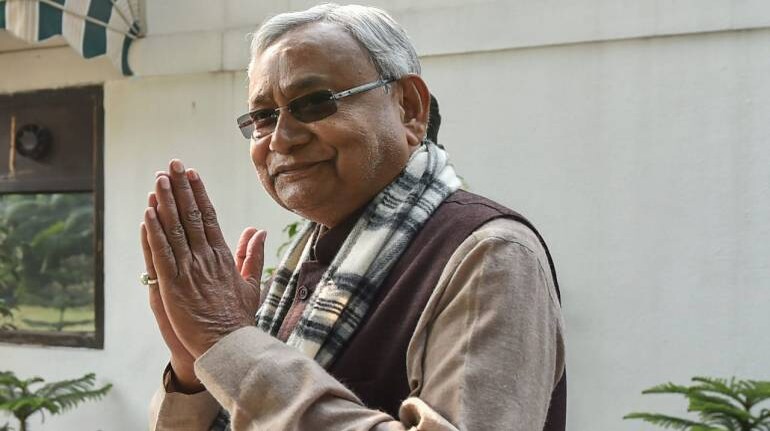
Bihar Chief Minister and Janata Dal (United) chief Nitish Kumar is leading the ruling National Democratic Alliance (NDA)’s charge in Bihar.
The 68-year-old managed to broker a good deal for his party, convincing the Bharatiya Janata Party (BJP) to fight 17 out of the state’s 40 seats, each. The BJP willing to contest 17 seats — five less than what it had won in 2014 — is being seen by political observes as a climbdown.
This, some suggest, showed how important Nitish and his party were for BJP’s prospects there.
Born in March 1951 in Bihar’s Bakhtiarpur to ayurvedic practitioner Ram Lakhan Singh and Parmeshwari Devi, Nitish earned a degree in mechanical engineering from Bihar College of Engineering before joining the Bihar State Electricity Board. He married Manju Kumari Sinha in 1973.
Soon, he quit his job and joined politics.
The political journey
Belonging to the socialist class of politicians, Nitish was an active member of the Jayaprakash Narayan movement between 1974 and 1977. During this time, he also became close to Bihar's eventual chief minister Satyendra Narayan Sinha.
In 1994, Nitish and George Fernandes came together to form the Samta Party. Their alliance with the BJP in the 1996 and 1998 Lok Sabha elections yielded good results and established Nitish as a leader.
In 1998-99, Nitish served as the Union Minister for Railways and Minister for Surface Transport and later as the Minister for Agriculture in the Atal Bihari Vajpayee government.
In 2000, Nitish became the chief minister of Bihar for the first time. However, his government lasted only eight days.
His party merged with Janata Dal (United) in 2003, which was also part of the NDA.
He returned as the railway minister in 2001, a position he served until the term ended in 2004.
Nitish was praised for undertaking major reforms in the Indian Railways such as internet ticketing, introduction of the tatkal scheme and opening a record number of ticketing counters.
He became the Bihar chief minister after JD(U) and BJP came to power in the state in 2005. The alliance convincingly won the 2010 election to retain power.
Nitish got recognition for the work he did in Bihar and by early 2013, it had become clear that Narendra Modi and Nitish were the two strongest possible candidates for the NDA for the 2014 Lok Sabha election.
In fact, he has been described by many as 'vikas purush (development man)'.
‘Flip-flopper’
Nitish has made several flip-flops in his career as a politician.
With a strong anti-incumbency factor looming over the Congress-led alliance at the Centre, Nitish sensed that the 2014 Lok Sabha election would be perhaps the right opportunity for the top job in Delhi.
His calculation was simple. If the BJP was unable to get a majority by itself, they would have to rely on JD(U)'s support and look at a more "secular face" for the prime ministerial position, thereby choosing him ahead of Modi.
However, when Modi became the de facto prime ministerial candidate of the NDA, Nitish decided to pull-out of the alliance.
The NDA got a thumping majority and Nitish's miscalculation was exposed. After winning just two seats (a loss of 18 seats from 2009), he was forced to take moral responsibility for the embarrassing loss and resign as chief minister. He was replaced by Jitan Ram Manjhi.
But, less than a year later, he returned as the chief minister, rallying party members — in what can be called an ugly in-fight within the JD(U) — behind him after Manjhi refused to step aside.
Fearing a wipe-out by the BJP, JD (U) tied up with the Congress and rival RJD.
In what came as a surprise to many, the 'Grand Alliance' won the election convincingly. But, the relationship between the three alliance members has not been cordial.
In April 2016, Lalu Prasad Yadav called Nitish the opposition's prime ministerial candidate for the 2019 Lok Sabha election, starting speculations about a grand alliance.
In November 2016, he praised PM Modi for carrying out demonetisation. Again, in June that year, his party backed BJP's Ram Nath Kovind as the presidential candidate. He also refused to participate in a meeting to discuss the opposition's vice-presidential candidate.
Finally, on July 26, 2017, Nitish resigned as the chief minister amid rift with the RJD over corruption charges against senior leaders of the party.
Often referred to as the ‘Chanakya of Bihar’, Nitish readily accepted BJP's support to continue in power — a move that took him from being a staunch Modi critic to an ally.
To many, his actions come across as political manoeuvres. In the past, like in 2014, such manoeuvring landed Nitish and his party in the dock. But sometimes, like in 2015, they work well for him too.
Discover the latest business news, Sensex, and Nifty updates. Obtain Personal Finance insights, tax queries, and expert opinions on Moneycontrol or download the Moneycontrol App to stay updated!